Charles E W Bean, Diaries, AWM38 3DRL 606/254/1 - 1917 - 1933 - Part 18
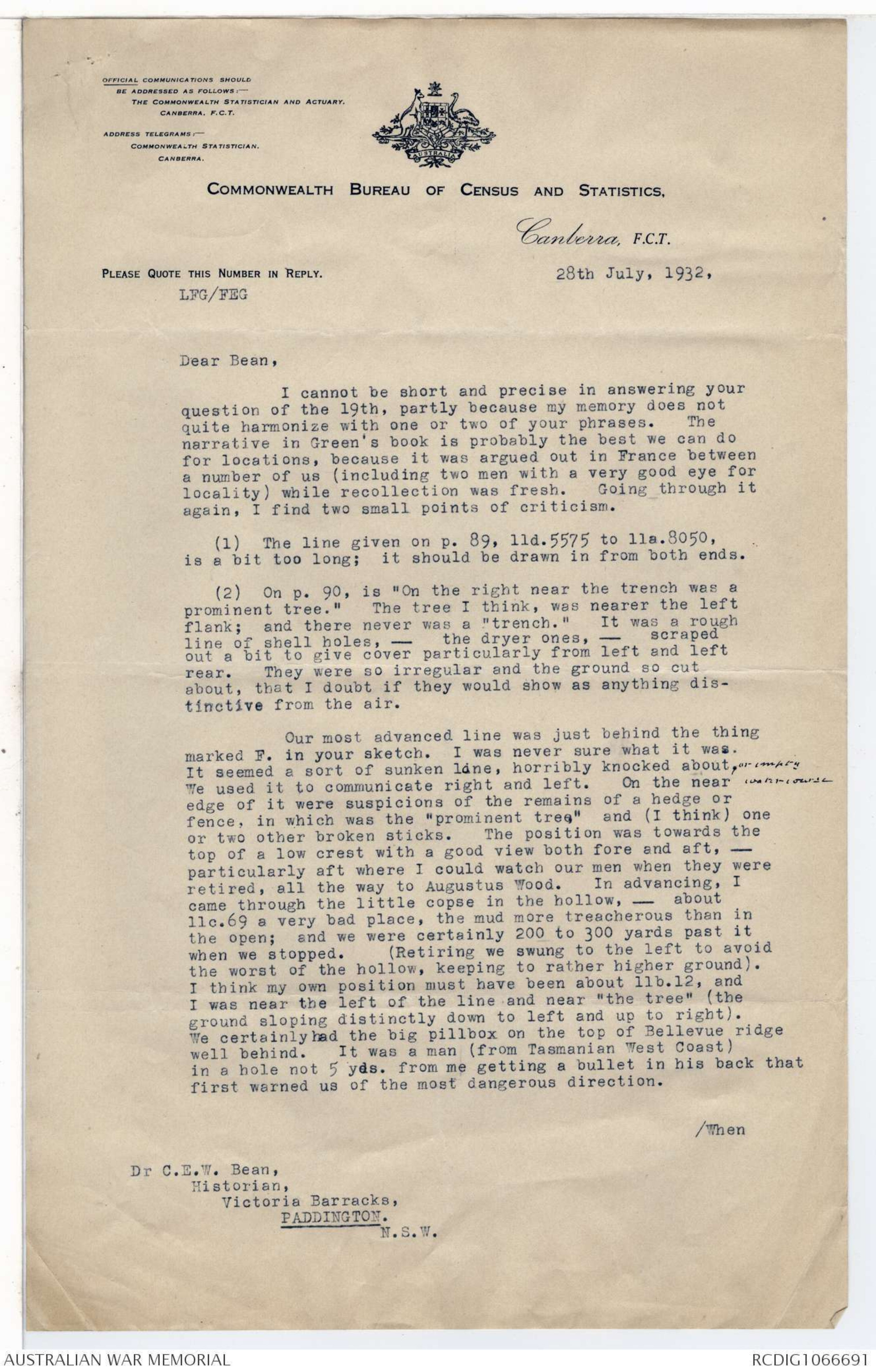
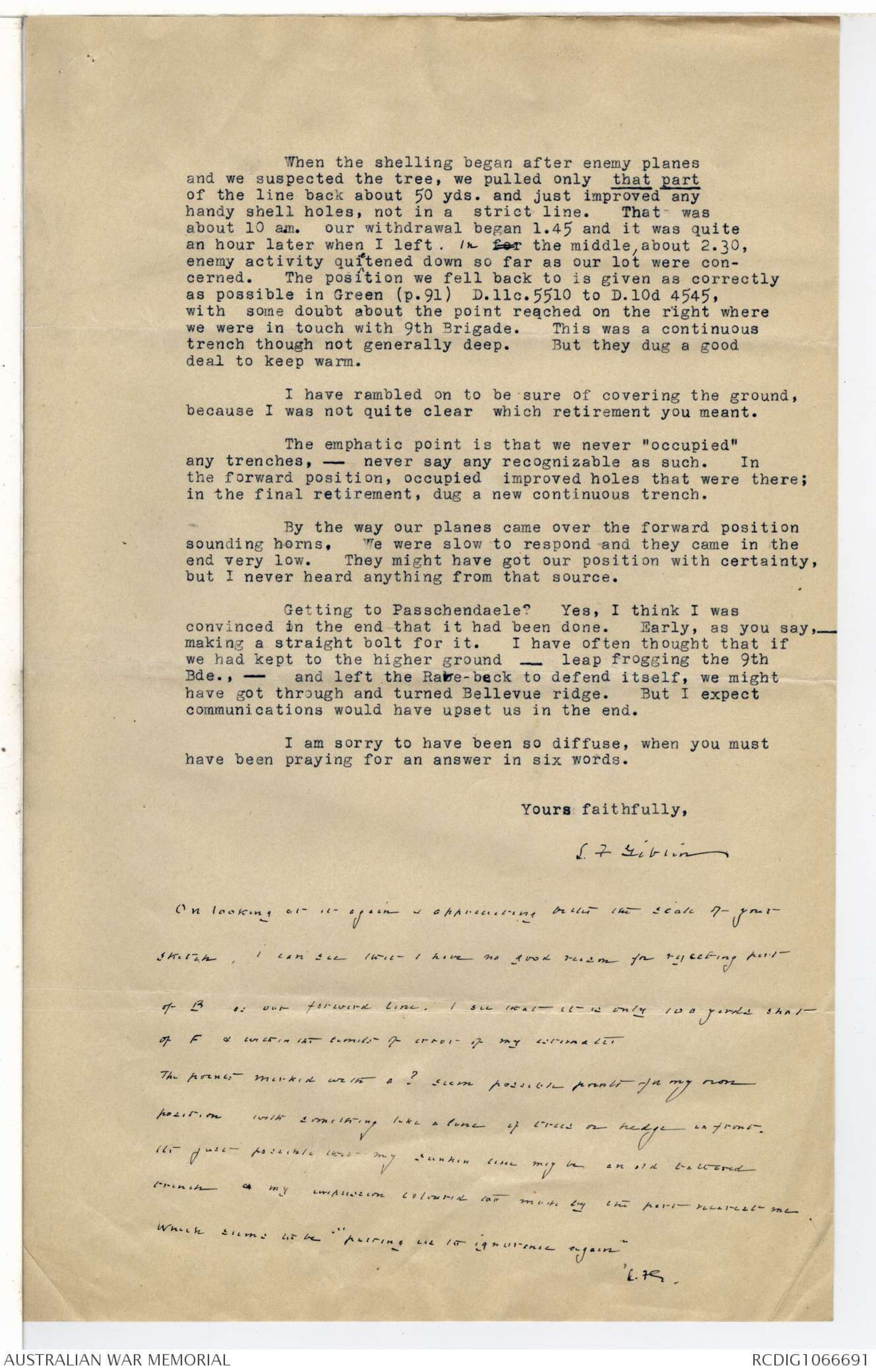

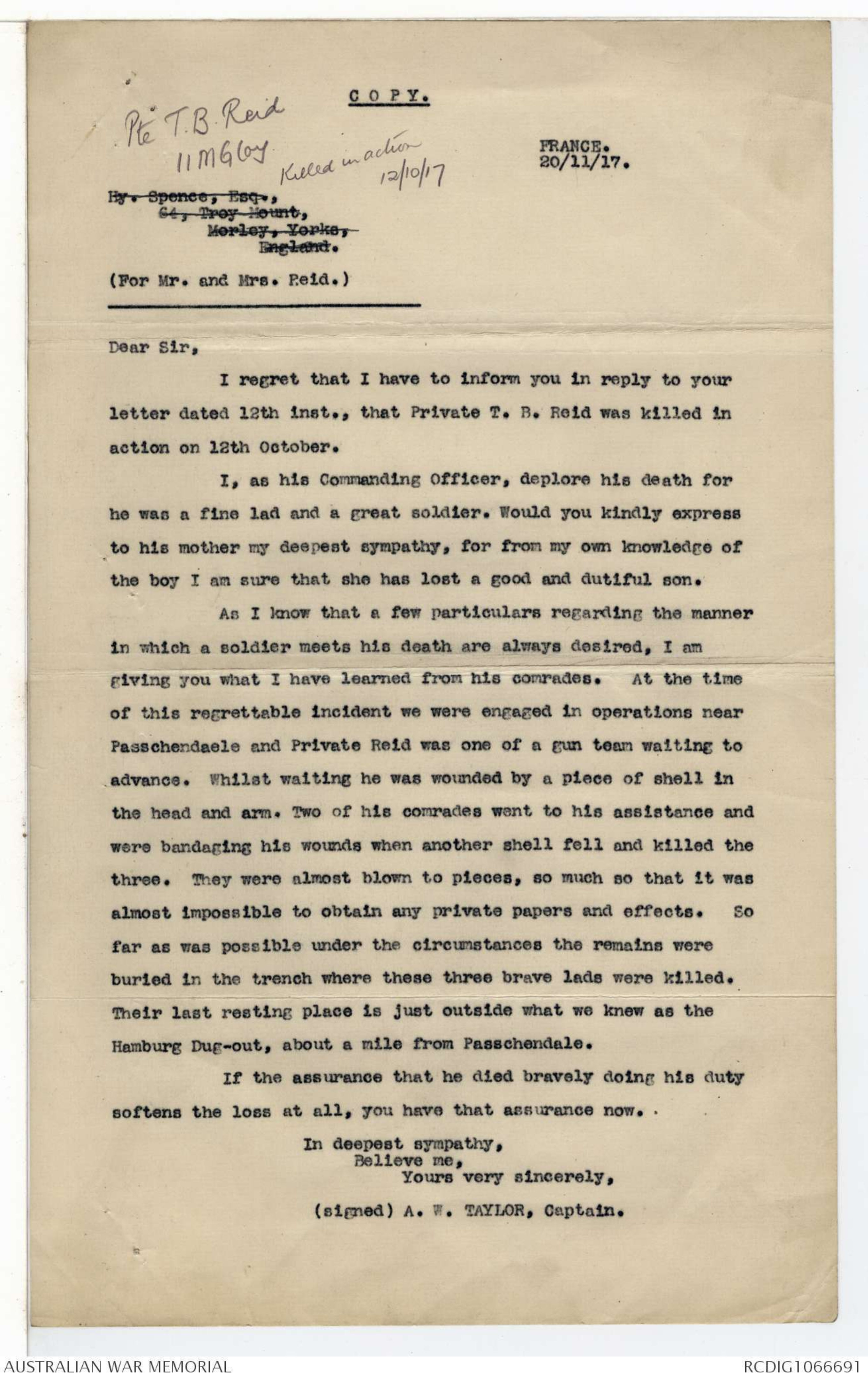
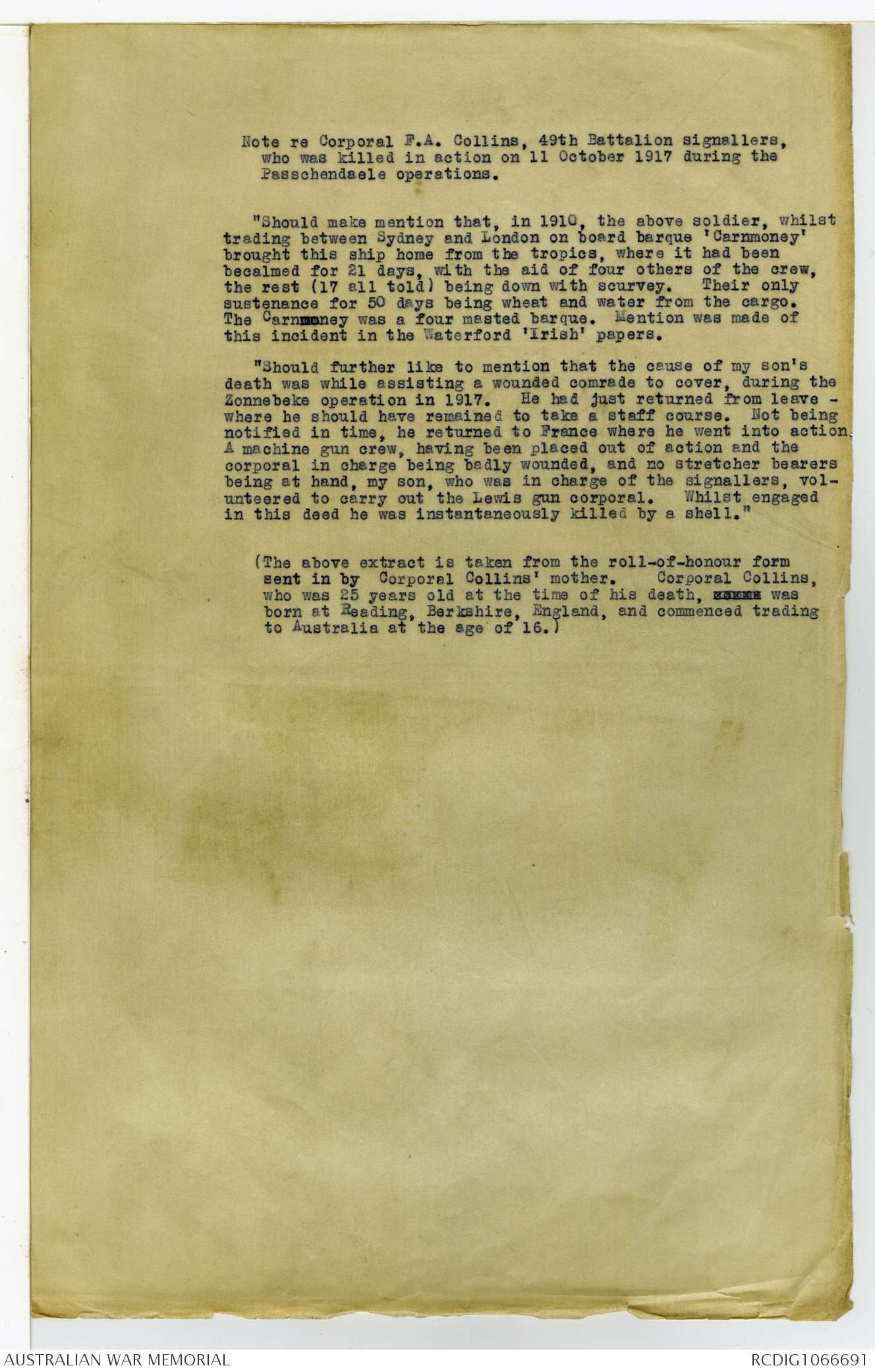

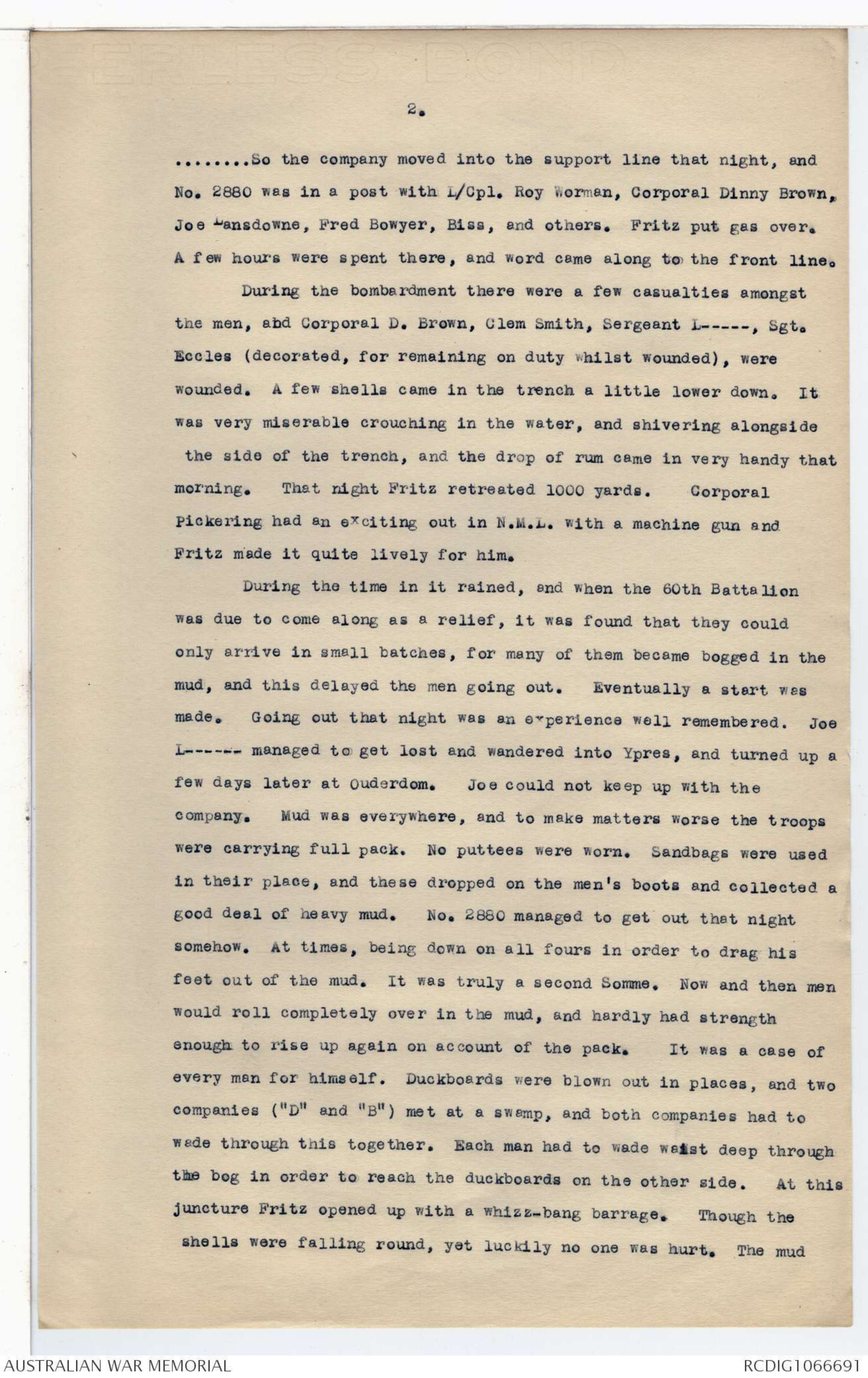


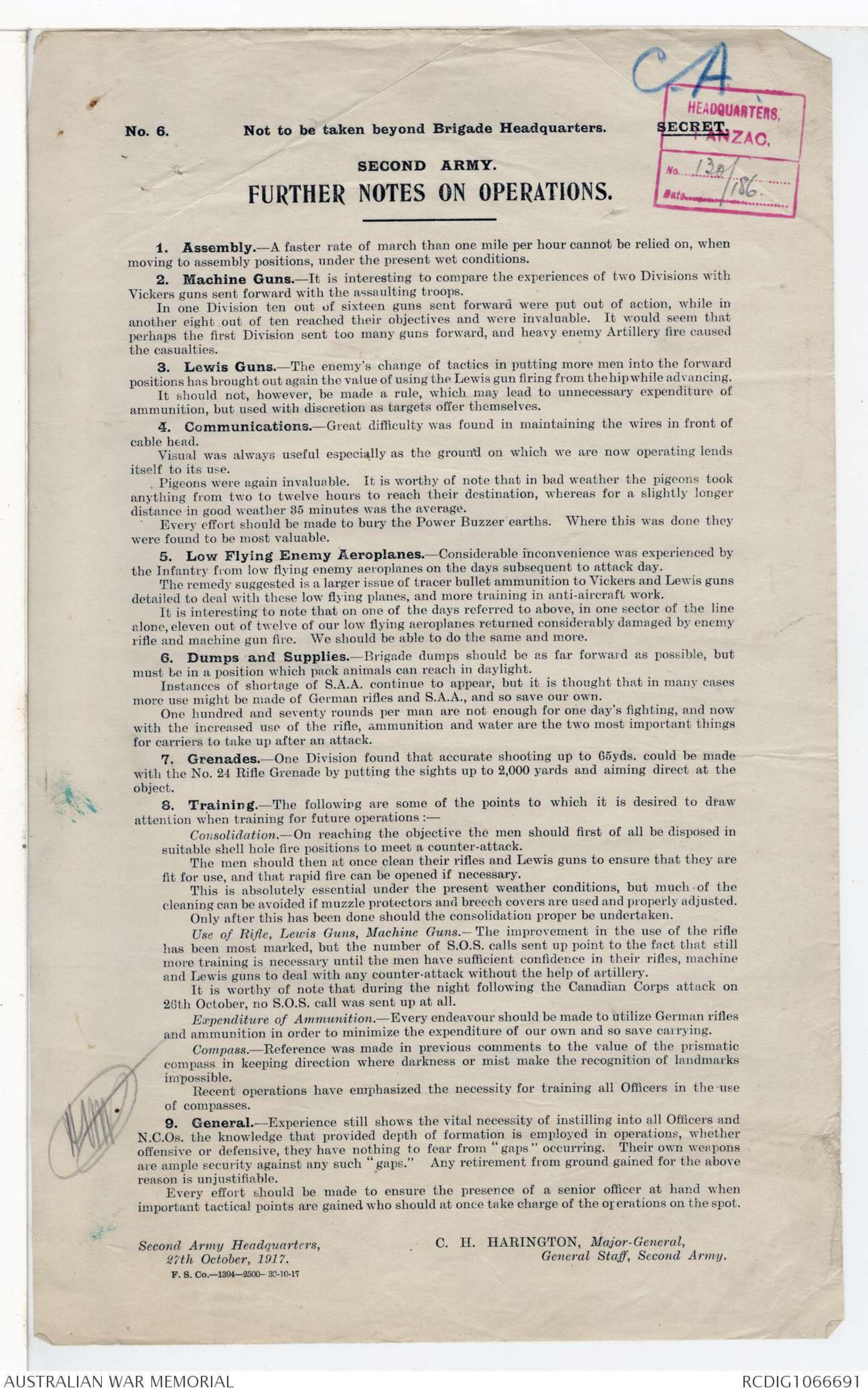
OFFICIAL COMMUNICATIONS SHOULD
BE ADDRESSED AS FOLLOWS: ----
THE COMMONWEALTH STATISTICIAN AND ACTUARY.
CANBERRA. F.C.T.
ADDRESS TELEGRAMS :-----
COMMONWEALTH STATISTICIAN.
CANBERRA
COMMONWEALTH BUREAU OF CENSUS AND STATISTICS,
CANBERRA, F.C.T.
PLEASE QUOTE THIS NUMBER IN REPLY.
LFG/FEG
28th July, 1932,
Dear Bean,
I cannot be short and precise in answering your
question of the 19th, partly because my memory does not
quite harmonize with one or two of your phrases. The
narrative in Green's book is probably the best we can do
for locations, because it was argued out in France between
a number of us (including two men with a very good eye for
locality) while recollection was fresh. Going through it
again, I find two small points of criticism.
(1) The line given on p. 89, 11d.5575 to 11a.8050,
is a bit too long; it should be drawn in from both ends.
(2) On p. 90, is "On the right near the trench was a
prominent tree. The tree I think, was nearer the left
flank; and there never was a "trench." It was a rough
line of shell holes, — the dryer ones, — scraped
out a bit to give cover particularly from left and left
rear. They were so irregular and the ground so cut
about, that I doubt if they would show as anything distinctive
from the air.
Our most advanced line was just behind the thing
marked F. in your sketch. I was never sure what it was.
It seemed a sort of sunken liane, horribly knocked about, or empty
We used it to communicate right and left. On the near water course
edge of it were suspicions of the remains of a hedge or
fence, in which was the "prominent tree", and (I think) one
or two other broken sticks. The position was towards the
top of a low crest with a good view both fore and aft, —
particularly aft where I could watch our men when they were
retired, all the way to Augustus Wood. In advancing, I
came through the little copse in the hollow, — about
11c.69 a very bad place, the mud more treacherous than in
the open; and we were certainly 200 to 300 yards past it
when we stopped. (Retiring we swung to the left to avoid
the worst of the hollow, keeping to rather higher ground).
I think my own position must have been about 11b.12, and
I was near the left of the line and near "the tree" (the
ground sloping distinctly down to left and up to right).
We certainly had the big pillbox on the top of Bellevue ridge
well behind. It was a man (from Tasmanian West Coast)
in a hole not 5 yds. from me getting a bullet in his back that
first warned us of the most dangerous direction.
/When
Dr C.E.W. Bean,
Historian,
Victoria Barracks,
PADDINGTON.
N.S.W.
When the shelling began after enemy planes
and we suspected the tree, we pulled only that part
of the line back about 50 yds. and just improved any
handy shell holes, not in a strict line. That was
about 10 am. our withdrawal began 1.45 and it was quite
an hour later when I left. In for the middle, about 2.30,
enemy activity quietened down so far as our lot were concerned.
The position we fell back to is given as correctly
as possible in Green (p.91) D.11c.5510 to D.10d 4545,
with some doubt about the point reached on the right where
we were in touch with 9th Brigade. This was a continuous
trench though not generally deep. But they dug a good
deal to keep warm.
I have rambled on to be sure of covering the ground,
because I was not quite clear which retirement you meant.
The emphatic point is that we never "occupied"
any trenches, — never say any recognizable as such. In
the forward position, occupied improved holes that were there;
in the final retirement, dug a new continuous trench.
By the way our planes came over the forward position
sounding horns. We were slow to respond and they came in the
end very low. They might have got our position with certainty,
but I never heard anything from that source.
Getting to Passchendaele? Yes, I think I was
convinced in the end that it had been done. Early, as you say, —
making a straight bolt for it. I have often thought that if
we had kept to the higher ground — leap frogging the 9th
Bde., — and left the Rabre-beck to defend itself, we might
have got through and turned Bellevue ridge. But I expect
communications would have upset us in the end.
I am sorry to have been so diffuse, when you must
have been praying for an answer in six words.
Yours faithfully,
S. F Gilbin
On looking at it again & appreciating better the scale of your
sketch, I can see that I have no good reason for rejecting part
of B as our forward line. I see that it is only 100 yards short
of F & within the limits of error of my estimates
The points marked with a ? seem possible [[?]] of a mg [[?]]
position with something like a line of trees or hedge in front.
its just possible that my sunken line may be an old battered
trench & my impression coloured too much by the part nearest me
which seem to be "pairing me to ignorance again"
S.F.G.
Diagram - see original document
The reference letters A B C D etc will
enable you to identify these trenches
on the tracing (in the corner →) of the map used at
the time. (Parts of there were old trenches)
("C was the trench
you indicated
to one on the map
as having been occupied.)
COPY.
[* Pte T.B. Reid
11 MG Coy
Killed in action
12/10/17 *]
FRANCE.
20/11/17.Hy. Spence, Esq.,64 Troy MountMorley, Yorks,England.
(For Mr. and Mrs. Reid)
Dear Sir,
I regret that I have to inform you in reply to your
letter dated 12th inst., that Private T. B. Reid was killed in
action on 12th October.
I, as his Commanding Officer, deplore his death for
he was a fine lad and a great soldier. Would you kindly express
to his mother my deepest sympathy, for from my own knowledge of
the boy I am sure that she has lost a good and dutiful son.
As I know that a few particulars regarding the manner
in which a soldier meets his death are always desired, I am
giving you what I have learned from his comrades. At the time
of this regrettable incident we were engaged in operations near
Passchendaele and Private Reid was one of a gun team waiting to
advance. Whilst waiting he was wounded by a piece of shell in
the head and arm. Two of his comrades went to his assistance and
were bandaging his wounds when another shell fell and killed the
three. They were almost blown to pieces, so much so that it was
almost impossible to obtain any private papers and effects. So
far as was possible under the circumstances the remains were
buried in the trench where these three brave lads were killed.
Their last resting place is just outside what we knew as the
Hamburg Dug-out, about a mile from Passchendale.
If the assurance that he died bravely doing his duty
softens the loss at all, you have that assurance now.
In deepest sympathy,
Believe me,
Yours very sincerely,
(signed) A. W. TAYLOR, Captain.
Note re Corporal F.A. Collins, 49th Battalion signallers,
who was killed in action on 11 October 1917 during the
Passchendaele operations.
"Should make mention that, in 1910, the above soldier, whilst
trading between Sydney and London on board barque 'Carnmoney'
brought this ship home from the tropics, where it had been
becalmed for 21 days, with the aid of four others of the crew,
the rest (17 all told) being down with scurvey. Their only
sustenance for 50 days being wheat and water from the cargo.
The Carnmoney was a four masted barque. Mention was made of
this incident in the Waterford 'Irish' papers.
"Should further like to mention that the cause of my son's
death was while assisting a wounded comrade to cover, during the
Zonnebeke operation in 1917. He had just returned from leave -
where he should have remained to take a staff course. Not being
notified in time, he returned to France where he went into action
A machine gun crew, having been placed out of action and the
corporal in charge being badly wounded, and no stretcher bearers
being at hand, my son, who was in charge of the signallers, volunteered
to carry out the Lewis gun corporal. Whilst engaged
in this deed he was instantaneously killed by a shell."
(The above extract is taken from the roll-of-honour form
sent in by Corporal Collins' mother. Corporal Collins,
who was 25 years old at the time of his death, comme was
born at Reading, Berkshire, England, and commenced trading
to Australia at the age of 16.)
EXTRACTS FROM THE DIARY OF 2880 Private J. S. Bartley, 30th
Battalion, A.I.EF.
On the 8th of October the battalion left a village . . .
and passing Ypres, not far from Hellfire Corner (Menin Road), Hyde
Park Corner, Half Way House, eventually moved down a corduroy road,
lined on each side with blown up waggons and dead mules, and struck
off amongst the big guns (9.2 howitzers). A guide led the party
along the duckboards, and managed to lose his way. The troops were
under constant shell fire. After about half an hour's delay the
guide eventaully found the right track, which led them past the 29th
Battalion and through very swampy country, where the duckboards
were occasionally missing and in their places were shell-holes.
All was going well until they came to a hollow where the batteries
were. Fritz was fairly quiet. Quite suddenly up went an S.O.S.
. . . . . . from the front trenches and the guns opened up, and Fritz put
down his barrage on the batteries. The din was awful. The sky
was alive with flashing fire. The troops were caught out in the
open. The order came from captain S....... to take cover in shell-holes. No. 2880 wi
with about six others lay in a large shell-hole. The shells fell
around and as each one crashed into the earth it caused it to
shake very much.
It seemed as if there were no possible hope of meeting anything
but a shell right in amongst them. So they lay there calmly
awaiting an expected fate. Luckily after a while Fritz calmed
down. Mr. F...... came along and gave the order to move forward.
No. 2880 and others immediately got up and kept up connection with
the men in the front and moving ahead in the darkness. Unfortunately
two men who were a little behind caught a bursting shell.
Poor old Dad Easlie (who was carrying the "dodger") was killed, and
those who were near him will never forget his dying cry. Harry
S---- was hit in several places, and badly hit on the head, and as
nobody knew of the whereabouts of the aid posts or dressing stations
he was laid in a shell-hole, and word was passed on to the 9th
Battalion, who were going out at the time, to try and take him out.
2.
. . . . So the company moved into the support line that night, and
No. 2880 was in a post with L/Cpl. Roy Worman, Corporal Dinny Brown,
Joe Lansdowne, Fred Bowyer, Biss, and others. Fritz put gas over.
A few hours were spent there, and word came along to the front line.
During the bombardment there were a few casualties amongst
the men, and Corporal D. Brown, Clem Smith, Sergeant L----, Sgt.
Eccles (decorated, for remaining on duty whilst wounded), were
wounded. A few shells came in the trench a little lower down. It
was very miserable crouching in the water, and shivering alongside
the side of the trench, and the drop of rum came in very handy that
morning. That night Fritz retreated 1000 yards. Corporal
Pickering had an exciting out in N.M.L. with a machine gun and
Fritz made it quite lively for him.
During the time in it rained, and when the 60th Battalion
was due to come along as a relief, it was found that they could
only arrive in small batches, for many of them became bogged in the
mud, and this delayed the men going out. Eventually a start was
made. Going out that night was an experience well remembered. Joe
L-—---- managed to get lost and wandered into Ypres, and turned up a
few days later at Ouderdom. Joe could not keep up with the
company. Mud was everywhere, and to make matters worse the troops
were carrying full pack. No puttees were worn. Sandbags were used
in their place, and these dropped on the men's boots and collected a
good deal of heavy mud. No. 2880 managed to get out that night
somehow. At times, being down on all fours in order to drag his
feet out of the mud. It was truly a second Somme. Now and then men
would roll completely over in the mud, and hardly had strength
enough to rise up again on account of the pack. It was a case of
every man for himself. Duckboards were blown out in places, and two
companies ("D" and "B") met at a swamp, and both companies had to
wade through this together. Each man had to wade waist deep through
the bog in order to reach the duckboards on the other side. At this
juncture Fritz opened up with a whizz-bang barrage. Though the
shells were falling round, yet luckily no one was hurt. The mud
3.
proved a great life-saver so far as the shells were concerned, as th
they penetrated far into the earth, and upon explosion they had a
great weight of earth to heave up, and thus little damage was done.
Corp. Pick, and No. 2880 were struggling out together and
Pick decided to take a rest, as he was dead beat. So his mate
pushed on. Pick was missing next day, and it was afterwards
discovered that he had been wounded in the foot and actually did
not know it at the time. However he turned up again later.
The company struck a sunken road, and moved along a corduroy
road a little before daylight, and Captain Stephens made a mistake
by leading the men towards the Hun lines. But this was soon
rectified and the men struggled along, and when daylight broke it
revealed little bodies of men covered with mud, who seemed to have
had a rough time the night before. It was laughable to see the
condition the men were in. Presently Nos. 2880 and 2929 jumped on
a cart and got a lift along the road, which was very acceptable.
A fair amount of gear was dumped that night, and Private E-----
came out minus his trousers, which had met with a catastrophe on
the barb wire.
The 60th Battalion relieved on the night of 13th October,
and on the morning of the l4th the men reached the bow huts at a
village not far from Shrapnel Corner. The next day a move was made
back to Ouderdom, and whilst there Fritz made it quite lively with
bombing raids . . . . . (For the next six weeks Pte Bartley with
ten others from the 30th, xxxx was attached for fatigue work to the
1st Aust. Tunnelling Company, and lived mostly in dugouts. At the
end of this work he remarks: "There was no doubt at the time that
dugout life made men windy".)
[* C.A *]
No. 4. Not to be taken beyond Brigade Headquarters. SECRET
[*HEADQUARTERS
1 ANZAC
No 130/180
Date *]
SECOND ARMY.
Further Notes on Operations.
The changes in the enemy's defensive tactics, viz, a concentration of machine guns and a
stronger system of defence generally in the forward areas, necessitate some modifications in our
methods of attack:
(i.) There must be a more systematic artillery bombardment of the forward areas than
there has been hitherto.
(ii.) The protective barrages, after the objectives have been reached, must not be
stationary, but must sweep forward and return to take on the infantry at the appointed
time.
(iii) Machine guns must be specially placed to deal with defended localities in
co-operation with the artillery.
(iv.) It will probably not be necessary to increase the strength of the first waves of the
assaulting troops, but there must be a large proportion of moppers, carefully organized and
distributed, and supports and reserves must be well closed up.
(v.) The condition of the ground of itself limits the depth of the objective.
[* CHH *]
15th October, 1917.
C. H. HARINGTON, Major-General,
General Staff, Second Army
[* C.A. *]
No. 6. Not to be taken beyond Brigade Headquarters. SECRET
[*HEADQUARTERS
1 ANZAC
No. 130/186
Date....*]
SECOND ARMY.
FURTHER NOTES ON OPERATIONS.
1. Assembly.—A faster rate of march than one mile per hour cannot be relied on, when
moving to assembly positions, under the present wet conditions.
2. Machine Guns.—It is interesting to compare the experiences of two Divisions with
Vickers guns sent forward with the assaulting troops.
In one Division ten out of sixteen guns sent forward were put out of action, while in
another eight out of ten reached their objectives and were invaluable. It would seem that
perhaps the first Division sent too many guns forward, and heavy enemy Artillery fire caused
the casualties.
3. Lewis Guns.—The enemy's change of tactics in putting more men into the forward
positions has brought out again the value of using the Lewis gun firing from the hip while advancing.
It should not, however, be made a rule, which may lead to unnecessary expenditure of
ammunition, but used with discretion as targets offer themselves.
4. Communications.—Great difficulty was found in maintaining the wires in front of
cable head.
Visual was always useful especially as the ground on which we are now operating lends
itself to its use.
Pigeons were again invaluable. It is worthy of note that in bad weather the pigeons took
anything from two to twelve hours to reach their destination, whereas for a slightly longer
distance in good weather 35 minutes was the average.
Every effort should be made to bury the Power Buzzer earths. Where this was done they
were found to be most valuable.
5. Low Flying Enemy Aeroplanes.—Considerable inconvenience was experienced by
the Infantry from low flying enemy aeroplanes on the days subsequent to attack day.
The remedy suggested is a larger issue of tracer bullet ammunition to Vickers and Lewis guns
detailed to deal with these low dying planes, and more training in anti-aircraft work.
It is interesting to note that on one of the days referred to above, in one sector of the line
along, eleven out of twelve of our low flying aeroplanes returned considerably damaged by enemy
rifle and machine gun fire. We should be able to do the same and more.
6. Dumps and Supplies.— Brigade dumps should be as far forward as possible, but
must be in a position which pack animals can reach in daylight.
Instances of shortage of S.A.A continue to appear, but it is thought that in many cases
more use might be made of German rifles and S.A.A. and so save our own.
One hundred and seventy rounds per man are not enough for one day's fighting, and now
with the increased use of the rifle, ammunition and water are the two most important things
for carriers to take up after an attack.
7. Grenades.—One Division found that accurate shooting up to 65yds, could be made
with the No. 24 Rifle Grenade by putting the sights up to 2,000 yards and aiming direct at the
object.
8. Training.—The following are some of the points to which it is desired to draw
attention when training for future operations:—
Consolidation.—On reaching the objective the men should first of all be disposed in
suitable shell hole fire positions to meet a counter-attack.
The men should then at once clean their rifles and Lewis guns to ensure that they are
fit for use, and that rapid fire can be opened if necessary.
This is absolutely essential under the present weather conditions, but much of the
cleaning can be avoided if muzzle protectors and breech covers are used and properly adjusted.
Only after this has been done should the consolidation proper be undertaken.
Use of Rifle, Lewis Guns, Machine Guns.—The improvement in the use of the rifle
has been most marked, but the number of S.O.S. calls sent up point to the fact that still
more training is necessary until the men have sufficient confidence in their rifles, machine
and Lewis guns to deal with any counter-attack without the help of artillery.
It is worthy of note that during the night following the Canadian Corps attack on
26th October, no SO.S. call was sent up at all.
Expenditure of Ammunition.—Every endeavour should be made to utilize German rifles
and ammunition in order to minimize the expenditure of our own and so save carrying.
Compass.—Reference was made in previous comments to the value of the prismatic
compass in keeping direction where darkness or mist make the recognition of landmarks
impossible.
Recent operations have emphasized the necessity for training all Officers in the use
of compasses.
[* CHH *]
9. General.—Experience still shows the vital necessity of instilling into all Officers and
N.C.O.s the knowledge that provided depth of formation is employed in operations, whether
offensive or defensive, they have nothing to fear from "gaps" occurring. Their own weapons
are ample security against any such "gaps." Any retirement from ground gained for the above
reason is unjustifiable.
Every effort should be made to ensure the presence of a senior officer at hand when
important tactical points are gained who should at once take charge of the operations on the spot.
C. H. HARINGTON, Major General,
General Staff, Second Army.
Second Army Headquarters,
27th October, 1917.
 Deb Parkinson
Deb ParkinsonThis transcription item is now locked to you for editing. To release the lock either Save your changes or Cancel.
This lock will be automatically released after 60 minutes of inactivity.